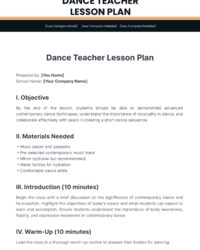Starting a dance class, whether you’re a seasoned instructor or just beginning your teaching journey, often brings a mix of excitement and a touch of overwhelm. You envision dynamic lessons, engaged students, and graceful movements, but translating that vision into a tangible, hour-by-hour structure can be quite the challenge. That’s where having a clear, adaptable framework comes into play, making your life significantly easier and your classes much more effective.
Imagine stepping into the studio feeling completely prepared, knowing exactly what you’ll teach, when, and how. This level of organization not only boosts your confidence but also ensures a smoother flow for your students, helping them progress consistently and confidently. A well-thought-out plan isn’t about rigidity; it’s about providing a roadmap that allows for creativity and spontaneity within a structured learning environment.
The Indispensable Value of a Structured Dance Class Plan
Let’s be honest, teaching dance is an art form in itself, but even artists need a canvas and a palette. A structured dance class lesson plan template acts as that essential foundation, providing numerous benefits that ripple through your teaching practice and directly impact your students’ learning experience. It helps maintain consistency across different classes or instructors, ensuring that all students receive a similar quality of instruction and progress at a comparable pace through your curriculum.
Beyond consistency, a good template empowers you to allocate your time wisely. How many times have you found yourself running out of time for the cool-down, or rushing through a new combination? A pre-planned structure helps you dedicate appropriate time to warm-ups, technical drills, choreography, creative exploration, and cool-downs, creating a balanced and holistic learning experience. It reduces on-the-fly decision-making, allowing you to focus more on your students’ technique and less on what comes next.
Moreover, a detailed plan serves as an excellent resource for reflection and improvement. After each class, you can review what worked well, what didn’t, and what adjustments need to be made for future sessions. This iterative process is crucial for growth, both as an instructor and for the overall quality of your dance program. It transforms your teaching from a series of individual sessions into a coherent, progressive journey for your students.
Ultimately, a structured plan fosters student success by providing clear expectations and a logical progression of skills. Students thrive when they understand the learning objectives and see how each step builds upon the last. It also makes substitute teaching much simpler, as another instructor can easily step in and deliver a class that aligns with your usual curriculum.
Core Components of an Effective Template
- Class Objectives: What do you want students to achieve by the end of the class?
- Warm-up Sequence: Essential for injury prevention and preparing the body.
- Technical Focus: Specific steps, turns, jumps, or foundational techniques.
- Choreography/Combination: The creative application of learned techniques.
- Improvisation/Creative Exploration: Time for self-expression and personal movement discovery.
- Cool-down and Stretching: Gradually bring heart rates down and improve flexibility.
- Music Selection: Specific songs or types of music for each segment.
- Prop Integration (Optional): If using scarves, hoops, or other props.
- Assessment/Feedback Points: Moments to observe and provide guidance.
Benefits for Teachers and Students
- For Teachers: Reduced planning stress, improved organization, greater confidence, easier substitute coverage.
- For Students: Clear progression, consistent learning, enhanced understanding, greater engagement.
Crafting Your Perfect Dance Class Lesson Plan Template
Creating a versatile dance class lesson plan template isn’t about finding a one-size-fits-all solution; it’s about developing a framework that you can adapt to various dance styles, age groups, and skill levels. Start by considering the fundamental building blocks of any dance class, as outlined above, and then think about how you can customize them. For instance, a warm-up for preschoolers will look vastly different from one for advanced contemporary dancers. The key is flexibility within the structure.
Think about the duration of your classes. A 45-minute beginner class will require a more concise plan than a 90-minute intermediate session. Factor in transition times between segments and allow for unexpected moments, like needing to re-explain a step or address a specific student’s challenge. Planning for these small pauses ensures that your class doesn’t feel rushed and that you can genuinely connect with your students. Remember, the template is a guide, not a rigid script you must adhere to minute by minute.
Finally, don’t be afraid to iterate and refine your template over time. The best lesson plans are living documents that evolve with your teaching experience and student feedback. After each class, take a few moments to jot down notes on what went well, what could be improved, and any spontaneous ideas that emerged. This continuous reflection will help you fine-tune your dance class lesson plan template, making it an even more powerful tool for delivering exceptional dance education.
- Consider the age group and their typical attention spans.
- Factor in the duration of your class and allocate time accordingly.
- Incorporate music selections that inspire and support the movement.
- Plan for smooth transitions between different activities.
- Allocate moments for questions, individual feedback, and group discussion.
Ultimately, having a solid plan allows you to focus less on the logistics and more on the art of teaching itself. It liberates your creativity, enabling you to bring your passion for dance fully into every session. Your preparedness shines through, inspiring confidence in your students and making every step of their dance journey a truly enriching experience.
Embrace the power of preparation, and watch how it transforms your teaching and your students’ learning. A well-structured class is a joyful class, for both the instructor and the dancers, fostering an environment where creativity flourishes and skills grow with every beat.


